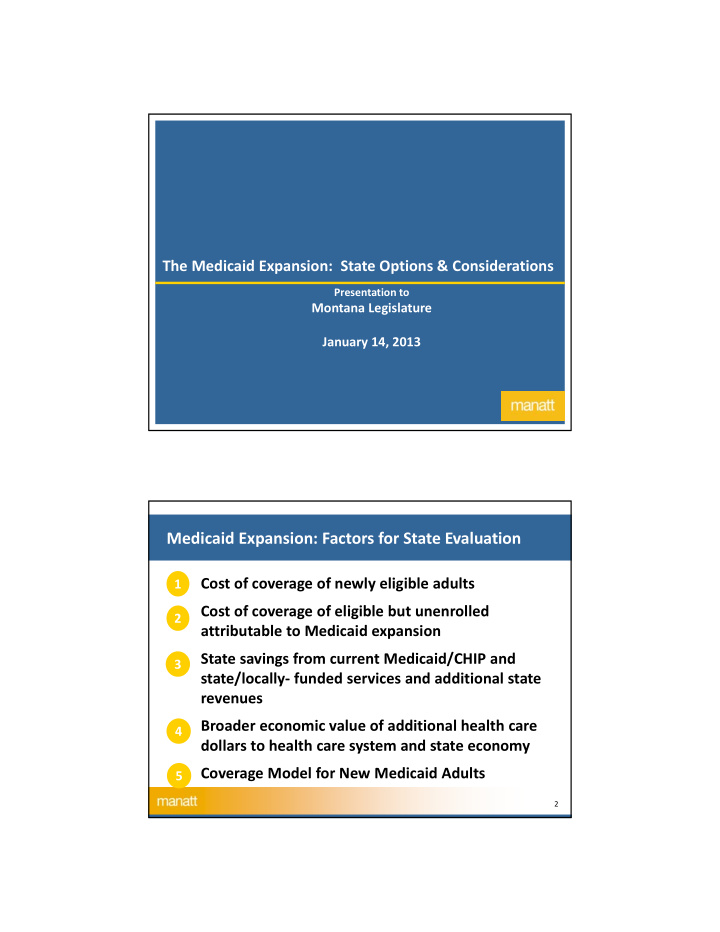



1/14/2013 The Medicaid Expansion: State Options & Considerations Presentation to Montana Legislature January 14, 2013 Medicaid Expansion: Factors for State Evaluation Cost of coverage of newly eligible adults 1 Cost of coverage of eligible but unenrolled 2 attributable to Medicaid expansion State savings from current Medicaid/CHIP and 3 state/locally ‐ funded services and additional state revenues Broader economic value of additional health care 4 dollars to health care system and state economy Coverage Model for New Medicaid Adults 5 2 1
1/14/2013 1 Calculating Costs of Coverage for Newly Eligible Adults 2014 ‐ 2020 2014 2015 2016 2017 2018 2019 2020 (cumulative) Total Number of Newly Eligible Number of Newly Eligible Who Take Up Cost Per Member Per Year Total Medicaid Costs of Newly Eligible State Share 0% 0% 0% 5% 6% 7% 10% State Subtotal 3 2 Calculating Cost of Coverage for Eligible but Unenrolled 2014 2015 2016 2017 2018 2019 2020 Cumulative Number of currently eligible but unenrolled Number who take up PMPY Cost Total Cost Percentage attributable to Medicaid expansion FMAP (regular) Subtotal – State Costs 4 2
1/14/2013 1&2 Calculating Administrative Costs 2014 2015 2016 2017 2018 2019 2020 Cumulative PMPY administrative costs Subtotal ‐ State Cost 5 Offset State/Local Savings & New State Revenue 3 Savings From: Current Medicaid populations that move to new adult group with enhanced federal matching dollars or to Exchange with federal premium tax credits Enhanced CHIP FMAP: Increases by 23 percentage points in 2015 Current state ‐ funded programs and services to uninsured individuals Current county ‐ and city ‐ funded programs and services for uninsured individuals New Revenue From: Provider/insurer fees or assessments General business taxes Source: Matthew Buettgens, Stan Dorn and Caitlin Carroll. "Consider Savings as Well as Costs," Robert Wood Johnson 6 Foundation, July 2011. 3
1/14/2013 Savings From Transitioning to New Adult Group New Adult Group: individuals with incomes below 133% FPL who are under age 65; not Enhanced FMAP pregnant; not entitled to or enrolled in Newly Eligible Adults up to 138% FPL Medicare; and, not eligible under an existing Year mandatory category. State Share Federal Share Newly Eligible Individuals : adults under age 65 with incomes below 138% of the FPL who 2014 0% 100% were not covered under state’s Medicaid Plan or under a Waiver with comprehensive 2015 0% 100% benefits as of December 1, 2009. 2016 0% 100% Enhanced FMAP : states will receive enhanced FMAP for adults within the new 2017 5% 95% adult group who are “newly eligible” beginning January 1, 2014. 2018 6% 94% 2019 7% 93% FMAP Proxy: HHS will establish a proxy methodology to adjust FMAP payment to states to take into account “newly eligible” 2020+ 10% 90% individuals who would have been eligible under another category in 2009 . 7 Offset State Savings: Medicaid/CHIP Programs 3a Estimated State Savings Potential Populations & Programs 2014 2015 2016 2017 2018 2019 2020 2014 ‐ 2020 (cumulative) Medicaid 1115 Waivers – Expansion Populations Breast and Cervical Cancer Treatment Program Family Planning Waiver/SPAs Enhanced CHIP FMAP in 2015 Pregnant Women Other Subtotal: Savings 8 4
1/14/2013 3b Offset State Savings: State/Locally ‐ Funded Programs Estimated State Savings Programs and Services for the Uninsured 2014 ‐ 2020 2014 2015 2016 2017 2018 2019 2020 (cumulative) Coverage for specific diseases/conditions Funding for certain public health services State/local mental health spending State/local substance abuse spending State High Risk Pool Costs for inpatient care of prisoners State/local indigent care funding Other Subtotal: Savings 9 Offset New State Revenue 3c Estimated State Revenue 2014 2015 2016 2017 2018 2019 2020 2014 ‐ 2020 (cumulative) Provider Fees/Assessments Plan Fees/Assessment General Business Taxes Other Other Total: Revenue Note: State Revenues to be populated using Input/Output Model 10 5
1/14/2013 Offset Total State Savings & State Revenue 3d State Savings & Revenue 2014 ‐ 2020 2014 2015 2016 2017 2018 2019 2020 (cumulative) Current Medicaid Populations and Programs Current State/Locally ‐ Funded Programs for the Uninsured New State Revenue TOTAL 11 Medicaid Expansion: 1 + 2 ‐ 3 Fiscal Impact 2014 ‐ 2020 State Savings & Revenue State Costs 2014 ‐ 2020 2014 ‐ 2020 Current Medicaid/CHIP Newly Eligible Adults Populations and Programs Current State/Locally ‐ Currently Eligible but Funded Programs for the Unenrolled Uninsured Administration New State Revenue TOTAL X TOTAL Y X – Y = Medicaid Expansion Related Costs 2014 ‐ 2020 12 6
1/14/2013 5 Coverage Model for Medicaid New Adults Determine Alternative Benefit Plan (Benchmark benefits) Compare to Medicaid standard benefits Compare to benefits offered by qualified health plans in the Exchange Consider whether and how to apply cost ‐ sharing Generally limited, but new federal guidance expected shortly Evaluate purchasing models Fee ‐ for ‐ service Managed fee ‐ for ‐ service Medicaid managed care Qualified health plans 13 State Decisions Reasons to expand; States cite: Health insurance will be available to more residents The economics Opportunity to reform Medicaid and drive system wide reform Costs of not expanding Reasons not to expand; States cite: The economics Enhanced FMAP may not hold Medicaid is broken 14 7
1/14/2013 Questions? Manatt Health Solutions Deborah Bachrach dbachrach@manatt.com 212 ‐ 790 ‐ 4594 15 8
Recommend
More recommend